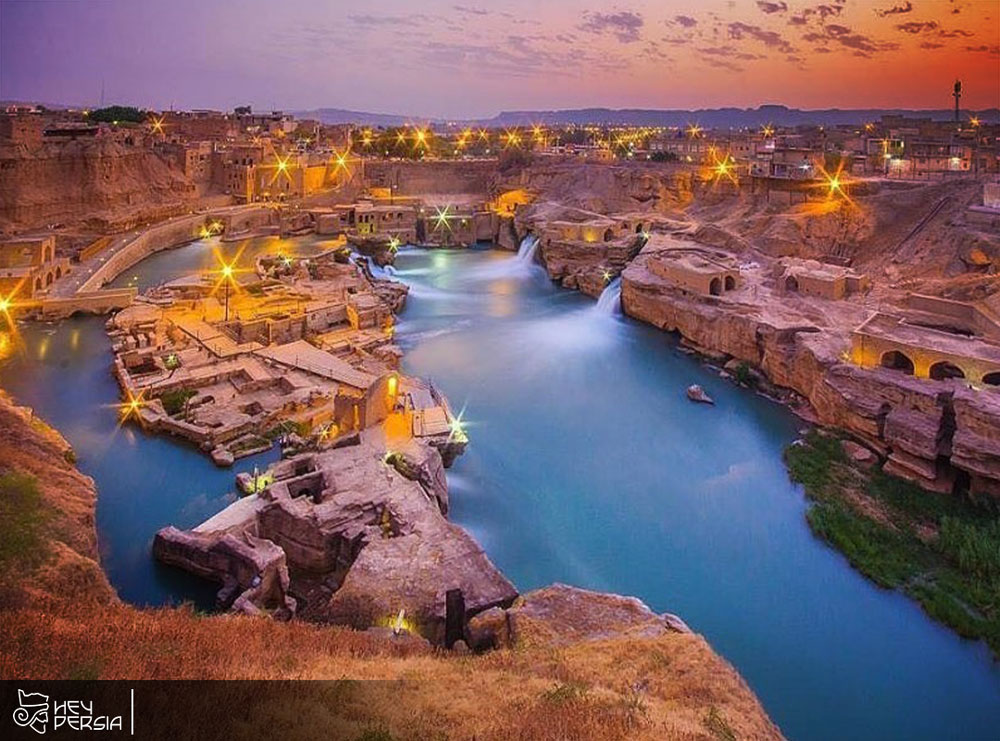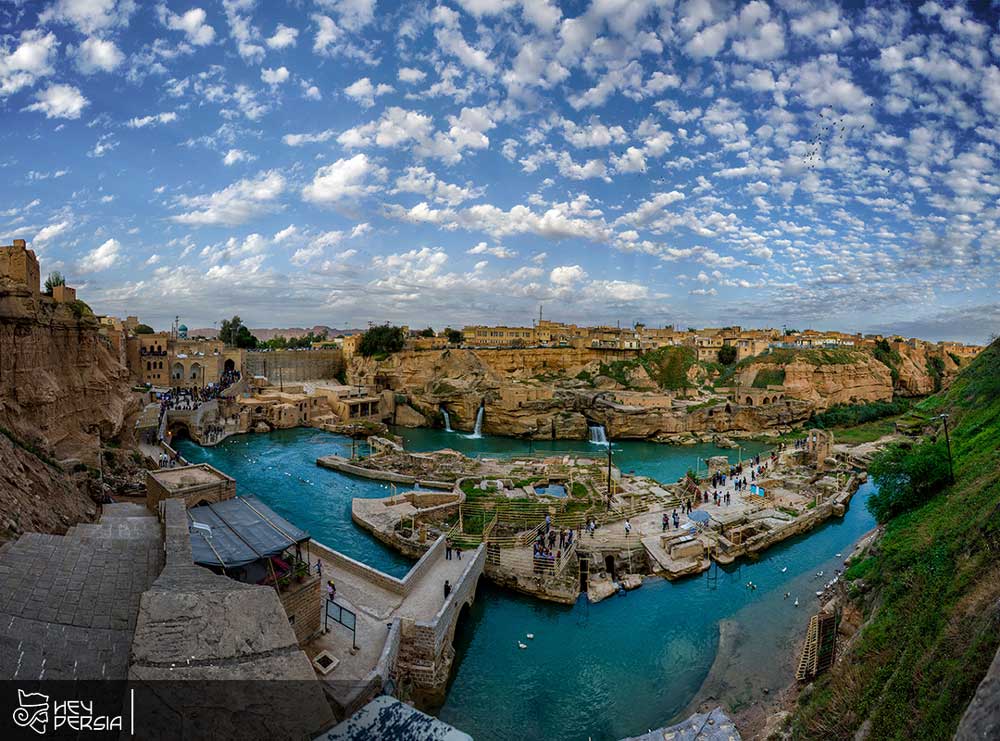Did you know that The City of Shushtar in Iran is 10 thousand years old and this city was the capital of Khuzestan province until the time of Reza Khan Pahlavi?! If you are looking for an important tourist attraction with good weather in the winter season, we suggest you travel to Shushtar. Today, in Atraq blog, we are going to talk about the most unique engineering structures in the world in the city of Shushtar, Khuzestan province, the race of the people of Shushtar, the reason for naming this city, the sights of Shushtar, the history of the city of Shushtar, access routes to Shushtar and accommodation in Shushtar. Join us at Hey Persia.
Where is The City of Shushtar in Iran
Shushtar is one of the cities of Khuzestan province, which after Ahvaz, Dezful and Abadan, is the fourth most populated city in the province and has an area of about 3440 square kilometers. This city is also by nicknames such as “Dar al-Mominin” and “Iran’s capital of water structures”.
History of The City of Shushtar in Iran
To examine the history of Shushtar, we must look at it from two perspectives. First, we will examine the history of settlement in the Shushtar region, and in the next step, we will talk about the history of Shushtar. So stay with us: According to the research conducted by the famous French archaeologist “Romain Girshman” in the outskirts of Shushtar city, he considers “Pideh Cave” to be the first human settlement in Iran. Ghar Pideh is one of the most important limestone caves in Iran, which dates back to the prehistoric period of the “Stone Age”.
According to “Walter Heinz”, a German Iranian scholar, Shushtar is most likely the same city that was “Adamden” in the Elam civilization. According to these issues and based on the ancient works discovered in this area, the city of Shushtar dates back to about 10 thousand years ago. Shushtar has attacked and destroyed many times in different periods, this city had its peak development in the Sassanid period and repopulated in the Safavid period after years of destruction. Shushtar alone has 13 registered works of world heritage. People of Shushtar speak Persian with Shushtri dialect. Of course, the people of this region also speak Bakhtiari and Arabic. The people of Shushtar are Muslims and their religion is 12 Imam Shia.
What is the name of The City of Shushtar in Iran?
If you have paid attention to the meaning of Shushtar, you should know what Shushtar means and why this city was Shushtar. Shushtar means better than “Shush”. Since the city of Shush was on the verge of destruction, a new city called Shushtar was 6 miles from it. This city had a better climate and its soil was more fertile. The city of Shushtar has very fertile soil due to the passage of 2 rivers “Karon” and “Dez” in this area. This has caused agriculture to flourish in this area and over time we will see many ancient sights in the area. In such a way that many archaeologists call this city as an engineering masterpiece.

The City of Shushtar in Iran water structures
In the ancient period, there are 13 independent water structures in Shushtar. They include dams, bridges, mills, waterfalls and canals that were by hand. These 13 complexes, which are at a short distance from each other in the city limits.Built in the Achaemenid to Sasanian period and work together as a comprehensive hydraulic system.
What are the water structures of Shushtar?
Shushtar water structures as the 10th historic monument of Iran in UNESCO include the following:
1- Shushtar amount clause
Shushtar Mizan dam is a very important historical work in the Shushtar water structure complex that divides the Karun river into 2 branches named “Shatit” and “Gargar”. This dam was by the order of Shapur I in the Sassanid period and was in the national register in 1378.
2- Kolah Ferangi mansion
One of the most important structures in Shushtar, which was to monitor the work of Mizan dam workers, is the Octagonal Tower of Kolah Ferangi. This building was in the Achaemenid period, but unfortunately it destroyed over time and only 3 meters of it remained.
3- Shadarvan Bridge
Shadarvan Bridge, which is also as Qaiser Dam, is a 500-meter bridge that was built 300 meters from Mizan Dam and on the main branch of Karun in the Sassanid period.
4- Salas Castle
Salas Castle was in the Achaemenid period and is not a water structure; But because of its role in controlling the Darion creek, it has been included in the set of water structures. This castle was not only responsible for controlling and guiding the water, but it was also to defend the city.
5- Band Dokhtar
Band Dokhtar is a dam in the last mountain pass on the Karun River.

6- Dam of Dara
Dara Dam was in the Achaemenid period and was located on the Gargar River in the Miyanab region.
7- Band of fishermen
Fisherman’s Dam on the Gregar River was by hand, and because of keeping the water level high, it is as one of the engineering marvels of Shushtri structures.
8- The collection of The City of Shushtar in Iran waterfalls and mills
The Shushtar waterfalls and mills complex is the largest and most visited water structure in Shushtar, where there are many water mills.
9- Lashkar Dam bridge
Lashkar Bridge is one of the healthiest water structures in Shushtar, which is also known as Lashkar Gate. Bricks, stones and mud have been used in the construction of this dam. Lashkar Bridge is one of the six gates of Shushtar and there are 3 mills on its southern side and four arches on the rock at the end of its northern side.
10- Sharabdar Bridge
It is located on the “Raqat” stream, which is one of the branches of the Darion stream, called Band Sherabdar. This embankment is made of mud and stone in an east-west direction. This dam is located between Lashkar and Mahi Bazan dams and was built during the Parthian period.
11- The Stairs
200 hand-made stone stairs were built in the south of the mills and waterfalls area, through which the waterfalls lead to the residential areas overlooking the complex. are connected In the way of the stairs, rooms were also built for the guards who protected the water structures.
12- Sika
Sika consists of chambers and narrow corridors that were built by the rivers and people used them for recreation. Sika has transitional openings and is built overlooking the Gargar river, and the water in them comes down strongly from above and rotates the mill wheel to prepare flour.
13- Shah Ali bridge
Shah Ali Bridge on the Darion River was built during the Sassanid period and was restored during the Safavid period. This bridge is located in the south of Shushtar city and in the west of Imamzade Abdullah.
Other places in The City of Shushtar in Iran
Zoroastrian cemetery in Shushtar. As you know, the crypt is the place where Zoroastrians leave their bodies so that they return to nature after death. There is also a crypt in Shushtar that dates back to the Medes period.

Shushtar Grand Mosque
One of the sights of Shushtar that was in this area after Islam is Shushtar Grand Mosque. This mosque dates back to 1200 years ago. Shushtar Grand Mosque is of clay and mud and has several naves and porticoes.
Bagh Khan The City of Shushtar in Iran
Bagh Khan is one of the must-see places in Shushtar and one of the national monuments of Iran, which was in the Qajar period on the western bank of the Gargar river. Most of the trees in Bagh Khan are fruit trees and their irrigation has done through canals and Shushtri mills.
Old houses of Shushtar
In addition to its sights, Shushtar also has old houses that were during the Qajar period. Among them, we can mention the Mustofi house, which belonged to one of the Shushtar merchants, “Mohammed Ali Mustofi”, and was during the time of Muzaffaruddin Shah. Among the other old houses of Shushtar, we can mention the Aminzadeh house, which is very famous for its decorations, or the Marashi house. It should be that all 3 of these houses are in the list of national works of Iran.
Shushtar Dam
Band-Khak is another step and water structure of Shushtar, which was in the Sasanian period and controls the water of the stream and flows into the Raqat stream.
Afzal Caravanserai
Afzal Caravanserai is a 4-story mansion and one of the most famous places in Shushtar, which was in the Qajar period with an area of 1000 square meters and belonged to the Afzal family. Generally, Today, this caravanserai has become a permanent exhibition of handicrafts.
Karai protected area
Karai protected area is one of the scenic and natural places of Shushtar, which is located 25 km from this city with an area of 40,000 hectares. The vegetation of this protected area is more of a pasture type and includes plants such as mountain almonds, mountain figs, kalkhang, ramlik, serim, gazelle, chicory, leguminous, barhang, yarrow, oregano and side tree. Additionally, The wildlife of this area also includes animals such as rams, sheep, wolves, tigers, tigers, partridges, and leopards.
Access routes to The City of Shushtar in Iran
There are air, rail and road routes to travel to Shushtar, which we will discuss below:
Air route
Shushtar does not have an airport. If you want to travel to the region by air, you should fly to Ahvaz or Dezful and then take a taxi from there to Shushtar. The distance between Ahvaz and Shushtar is about 90 kilometers and the distance between Shushtar and Dezful is about 60 kilometers.
railway track
Shushtar has a train station and you can use the Tehran-Ahvaz train and get off at Shushtar.
Road route
If you plan to go to Shushtar by private car or bus, you should reach Shushtar from Ahvaz, Dezful, Masjid Suleiman, etc. If you go to Shushtar from Shush, you must enter Haft Tepe, Chaghazanbil and finally Shushtar.
The City of Shushtar in Iran
Generally, Khuzestan province is one of the important provinces of Iran, which is not only very important in terms of oil and gas, but its diverse tourist attractions have made this province more popular Most of us like to travel in a group with some of our friends. But sometimes our friends are not with us on our journey due to many reasons. In this situation, using tours and group trips helps us to expand our circle of friends.
Atraq is one of the travel agencies that tries to provide attractive and unique trips for the middle-aged by offering various travel tours for this age group. At Atraq, we will do our best to provide services suitable for your age and dignity and to satisfy you. It is enough to join us once in Iran tours to become our constant companions.





